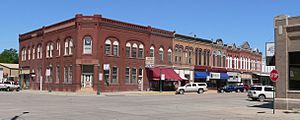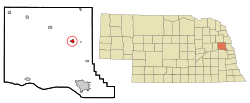Hooper, Nebraska facts for kids
Quick facts for kids
Hooper, Nebraska
|
|
|---|---|

Downtown Hooper: northwest corner of Main and Fulton
|
|

Location of Hooper, Nebraska
|
|
| Country | United States |
| State | Nebraska |
| County | Dodge |
| Area | |
| • Total | 0.69 sq mi (1.79 km2) |
| • Land | 0.68 sq mi (1.76 km2) |
| • Water | 0.01 sq mi (0.03 km2) |
| Elevation | 1,227 ft (374 m) |
| Population
(2020)
|
|
| • Total | 857 |
| • Density | 1,258.44/sq mi (486.12/km2) |
| Time zone | UTC-6 (Central (CST)) |
| • Summer (DST) | UTC-5 (CDT) |
| ZIP code |
68031
|
| Area code(s) | 402 |
| FIPS code | 31-23025 |
| GNIS feature ID | 2394414 |
Hooper is a city in Dodge County, Nebraska, United States. The population was 830 at the 2010 census.
History
Hooper was established in 1871, following construction of the Fremont, Elkhorn and Missouri Valley Railroad through the territory. It was named for Samuel Hooper, a US congressman from Massachusetts.
By the mid-1970s, the future of railroad service came into question. The Chicago & North Western (C&NW) (successor to the FE&MV RR) tracks were experiencing mildly declining freight traffic levels. In spring of 1982, flooding from the Elkhorn River & nearby Pebble Creek damaged the track. With the declining freight traffic levels & flooding damage, the C&NW promptly filed a request with the Interstate Commerce Commission to abandon the line. Permission was granted later that year, leaving the tracks with a dismal future.
In 1986, railroad service was revived by the newly formed Fremont & Elkhorn Valley Railroad (FEVR), which took ownership of the abandoned C&NW track. However, a bridge north of Nickerson was deemed unsafe to cross in 2003; as a result, FEVR embargoed train service through Hooper.. In summer 2021, the tracks were dismantled as part of an effort to construct a bike path following the old railroad route.
Geography
According to the United States Census Bureau, the city has a total area of 0.66 square miles (1.71 km2), of which 0.65 square miles (1.68 km2) is land and 0.01 square miles (0.03 km2) is water.
Demographics
| Historical population | |||
|---|---|---|---|
| Census | Pop. | %± | |
| 1880 | 204 | — | |
| 1890 | 670 | 228.4% | |
| 1900 | 840 | 25.4% | |
| 1910 | 741 | −11.8% | |
| 1920 | 1,014 | 36.8% | |
| 1930 | 985 | −2.9% | |
| 1940 | 802 | −18.6% | |
| 1950 | 859 | 7.1% | |
| 1960 | 832 | −3.1% | |
| 1970 | 895 | 7.6% | |
| 1980 | 932 | 4.1% | |
| 1990 | 850 | −8.8% | |
| 2000 | 827 | −2.7% | |
| 2010 | 830 | 0.4% | |
| 2020 | 857 | 3.3% | |
| U.S. Decennial Census | |||
2010 census
As of the census of 2010, there were 830 people, 359 households, and 228 families living in the city. The population density was 1,276.9 inhabitants per square mile (493.0/km2). There were 396 housing units at an average density of 609.2 per square mile (235.2/km2). The racial makeup of the city was 98.1% White, 0.1% Pacific Islander, 0.2% from other races, and 1.6% from two or more races. Hispanic or Latino of any race were 1.6% of the population.
There were 359 households, of which 28.7% had children under the age of 18 living with them, 51.0% were married couples living together, 7.8% had a female householder with no husband present, 4.7% had a male householder with no wife present, and 36.5% were non-families. 33.4% of all households were made up of individuals, and 18.7% had someone living alone who was 65 years of age or older. The average household size was 2.23 and the average family size was 2.83.
The median age in the city was 45.2 years. 22.2% of residents were under the age of 18; 4.8% were between the ages of 18 and 24; 22.8% were from 25 to 44; 25.5% were from 45 to 64; and 24.7% were 65 years of age or older. The gender makeup of the city was 49.4% male and 50.6% female.
Landmarks
Hooper is noted for a 24-foot (7.3 m) tower, with the town's name in 18-inch (460 mm) letters, completed in 2010 as a road sign for the town. The tower was constructed alongside a new bypass on U.S. Route 275 that diverted the highway around the town and raised concerns that the town would be unnoticed by passing traffic.
Notable people
- Lillian Boyer, legendary aerial daredevil, wing walker 1920s
- Jordan Larson, volleyball player at the University of Nebraska–Lincoln; world champion and Olympic gold medalist for the United States women's national volleyball team
- Donald K. Schwab, first lieutenant in the US Army in World War II; awarded Medal of Honor March 18, 2014 for heroism near Lure, France on September 17, 1944
See also
 In Spanish: Hooper (Nebraska) para niños
In Spanish: Hooper (Nebraska) para niños

